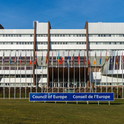I arrive in Moscow for the opening of my show "Fifty Seven Hours in the House of Culture," a series of paintings about the Dubrovka theatre siege of 2002. The exhibition is hosted at the Andrei Sakharov Museum, a memorial to the victims of Russian totalitarianism and a beacon of free expression and human rights in contemporary Russia. After a white-knuckle drive from Domodedovo airport, I check in at the Ukraina Hotel—one of the "seven sisters," the Stalinist classical-style monoliths scattered around central Moscow, with around a thousand rooms and 27 floors. It is the day of the journalist Anna Politkovskaya's funeral. She tried to intercede to resolve the Dubrovka siege peacefully, and I had asked her to write an introduction for the catalogue of the London showing of "Fifty Seven Hours" earlier this year, but she declined.
Wednesday 11th October
At the Sakharov Museum I meet Elena, the English-speaking exhibition co-ordinator, and Yuri Samodurov, the museum director. Yuri attended Politkovskaya's funeral yesterday, and is trying to organise a demonstration in protest over her murder. Two weeks earlier he had been arrested while attending a meeting about the Beslan school massacre. A founder of Memorial, the Russian human rights organisation, he is no stranger to controversy, having been prosecuted three years ago over an exhibition about religion which had "caused offence" to the Orthodox church, and was trashed by fundamentalists. The state wanted him imprisoned for two years, but a leading lawyer got him off with a fine. He tells me of the difficulty he had in finding funding for my exhibition, as the usual sponsors were unwilling to contribute to a show whose theme remains highly contentious. The British Council took four months to tell us that they would not be helping, but that may be because I am not on their list of approved artists (they refuse to give reasons). Eventually money was pledged by the director of a mobile phone company, who doesn't want his contribution acknowledged. Yuri tells me that two television channels have been in touch to cover the show, but he has declined rather than accept what he knows will be negative coverage.

I walk to Red Square, which is actually not as huge as I had imagined. Splendid mixture of confection (St Basil's), theatrical (the Kremlin Wall) and minimal (the Lenin Mausoleum). I'd always thought of Gum as a department store, but it's actually a shopping mall, and the most exquisite one I've ever been in. I take the metro from Revolution Square, where magnificently sculpted bronze workers support colonnades of arches the length of the station. After witnessing the grotesque documentation from the gulags at the Sakharov Museum display this morning, the travesty of this kitsch heroic portrayal sticks in my throat.

My wife Rosemary has arrived for a couple of nights. Elena rings to say she will send a driver to pick us up and meet her at the Dubrovka theatre. The theatre is in a complex distinguished only by its ordinariness, somewhere you would easily miss. On countless occasions I have imagined this car park as it was crossed by Olga Romanova, the local girl who for reasons known only to herself avoided the blockade, entered the theatre, harangued the terrorists and the hostages, and for her pains was taken out and shot. There is a memorial, cleverly inscribed by the government "To the Victims of Terror." There is no mention of the specific event which took place here, in which 129 hostages died, all but a handful as a result of the anaesthetic gas that was pumped into the auditorium by police. The composition of this gas has never been revealed. Near the entrance to the theatre is a plaque of victims' names, paid for by the bereaved.
The theatre is now unused, and outside hangs a banner (where once Nord Ost, the name of the musical that was interrupted by the siege, was proudly displayed) which proclaims "Italian fashions." Inside, the lobby is filled with stalls of cheap clothing. We want to gain access to the theatre, and go round to the back to speak to the security guards. On the way we pass the entrance to what was a gay club at the time, where it is conjectured that the Chechens gained access. The security man phones through to request permission to see inside the theatre, but the new owner is refusing access to anyone.

Afterwards people come over to talk to me—journalists and ex-hostages. Again, I feel relief that my exhibition is important to them. Finally we leave to go to a restaurant, where Yuri tells us of his grandmother, who spent 20 years in prison and exile, and his grandfather, who was executed. He describes an exhibition of photographs they recently put on at the museum, to which 40 journalists came but about which nothing was written.













